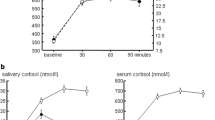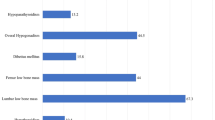Abstract
The variable presence of adrenal insufficiency (AI) due to hypocortisolemia (HC) in patients with thalassemia is well established; however, the prevalence of adrenocortical hypofunction (ACH) in the zona glomerulosa and zona reticularis of the adrenal cortex is unknown. To establish the prevalence of ACH, we examined the cortisol response to 1-µg and 250-µg ACTH tests, plasma aldosterone (A)/plasma renin activity (PRA) ratio, and serum dehydroepiandrosterone sulfate (DHEAS) levels in a large cohort of patients with thalassemia, and to investigate the impact of total body iron load (TBIL) on adrenocortical function. The setting used was University hospital and government-based tertiary care center. One hundred twenty-one (52 females) patients with β-thalassemia major (β-TM) and 72 healthy peers (38 females) were enrolled. The patients underwent a 250-µg cosyntropin test if their peak cortisol was <500 nmol/L in a 1-µg cosyntropin test. Magnetic resonance imaging (MRI) was performed to assess the MRI-based liver iron content and cardiac MRI T2* iron. The associations between ACH and TBIL were investigated. The patients with thalassemia had lower ACTH, cortisol, DHEAS, and A/PRA values compared with the controls (p < 0.001). Thirty-nine patients (32.2 %) had HC [primary (n = 1), central (n = 36), combined (n = 2)], and 47 (38.8 %) patients had reduced DHEAS levels; 29 (24.0 %) patients had reduced A/PRA ratios. Forty-six (38.0 %) patients had hypofunction in one of the adrenal zones, 26 (21.5 %) had hypofunction in two adrenal zones, and 9 (7.4 %) had hypofunction in all three zones. Patient age and TBIL surrogates were significant independent parameters associated with ACH. Cardiac MRI T2* iron was the only significant parameter that predicted the severity of ACH at a cut-off of 20.6 ms, with 81 % sensitivity and 78 % specificity. Patients with thalassemia have a high prevalence of AI due to HC and zona glomerulosa and zona reticularis hypofunction. TBIL surrogates can predict ACH, but cardiac iron was the only surrogate that was adequately sensitive to predict the severity of ACH.


Similar content being viewed by others
References
V. De Sanctis, N. Skordis, A. Soliman, Endocrine disease, in Guidelines for the Management of Transfusion Dependent Thalassemia, 3rd edn., ed. by M.D. Cappellini, A. Cohen, J. Porter, A. Taher, V. Viprakasit (Thalassemia International Federation, Nicosia, 2014), pp. 146–158
V. De Sanctis, C. Pintor, Italian Working Group on Endocrine Complications in Non-Endocrine Disease, Multicenter study on prevalence of endocrine complications in thalassemia major. Clin. Endocrinol. 42, 581–586 (1995)
H.H. Elsedfy, M. El Kholy, R. Tarif, A. Hamed, M. Elalfy, Adrenal function in thalassemia major adolescents. Pediatr. Endocrinol. Rev. 8(Suppl 2), 295–299 (2011)
A. Jacobs, Iron overload-clinic and pathologic aspects. Semin. Hematol. 14, 89–113 (1977)
A. Incebiyik, A. Genc, N.G. Hilali, A. Camuzcuoglu, H. Camuzcuoglu, A. Kilic, M. Vural, Prevalence of β-thalassemia trait and abnormal hemoglobins in Sanliurfa Province in Southeast Turkey. Hemoglobin 38, 402–404 (2014)
T.J. Cole, M.C. Bellizzi, K.M. Flegal, W.H. Dietz, Establishing a standard definition for child overweight and obesity worldwide: international survey. BMJ 320, 1240–1243 (2000)
National High Blood Pressure Education Program Working Group on High Blood Pressure in Children and Adolescents. The Fourth Report on the Diagnosis, Evaluation, and Treatment of High Blood Pressure in Children and Adolescents Pediatrics 114, 555–576 (2004)
R.M. Lang, M. Bierig, R.B. Devereux, F.A. Flachskampf, E. Foster, P.A. Pellikka, M.H. Picard, M.J. Roman, J. Seward, J.S. Shanewise, S.D. Solomon, K.T. Spencer, M. St John Sutton, W.J. Stewart, Recommendations for chamber quantification: a report from the American Society of Echocardiography’s Guidelines and Standards Committee and the chamber quantification writing group, developed in conjunction with the European Association of Echocardiography, a branch of the European Society of Cardiology. J. Am. Soc. Echocardiogr. 18, 1440–1463 (2005)
M. Westwood, L.J. Anderson, D.N. Firmin, P.D. Gatehouse, C.C. Charrier, B. Wonke, D.J. Pennell, A single breathold multiecho T2* cardiovascular magnetic resonance technique for diagnosis of myocardial iron overload. J. Magn. Reson. Imaging 18, 33–39 (2003)
J.C. Wood, C. Enriquez, N. Ghugre, J.M. Tyzka, S. Carson, M.D. Nelson, T.D. Coates, MRI R2 and R2* mapping accurately estimates hepatic iron concentration in transfusion-dependent thalassemia and sickle cell disease patients. Blood 106, 1460–1465 (2005)
J.S. Hankins, M.B. McCarville, R.B. Loeffler, M.P. Smeltzer, M. Onciu, F.A. Hoffer, C.S. Li, W.C. Wang, R.E. Ware, C.M. Hillenbrand, R2* magnetic resonance imaging of the liver in patients with iron overload. Blood 113(20), 4853–4855 (2009)
C.B. Barra, I.N. Silva, T.M. Rodrigues, J.L. Santos, E.A. Colosimo, Morning serum basal cortisol levels are affected by age and pubertal maturation in school-aged children and adolescents. Horm. Res. Paediatr. 83, 55–61 (2015)
B. Kirkwood, J. Sterne, Essential Medical Statistics, 2nd edn. (Blackwell Publishers, Oxford, 2003)
J.A. Hanley, B.J. McNeil, A method of comparing the areas under receiver operating characteristic curves derived from the same cases. Radiology 148, 839–843 (1983)
L.M. Sherief, S.M.A. El-Salam, N.M. Kamal, O. El safy, M.A.A. Almalky, S.F. Azab, H.M. Morsy, A.F. Gharieb, Nutritional biomarkers in Children and Adolescents with Beta-thalassemia major: an Egyptian center experience. Biomed. Res. Int. (2014). doi:10.1155/2014/261761
N. Skordis, M. Michaelidou, S.C. Savva, Y. Ioannou, A. Rousounides, M. Kleanthous, G. Skordos, S. Christou, The impact of genotype on endocrine complications in thalassaemia major. Eur. J. Haematol. 77, 150–156 (2006)
V. De Sanctis, A. Soliman, G. Candini, M. Yassin, G. Raiola, M.C. Galati, R. Elalaily, H. Elsedfy, N. Skordis, P. Garofalo, S. Anastasi, S. Campisi, M. Karimi, C. Kattamis, D. Canatan, Y. Kılınc, P. Sobti, B. Fiscina, M. El Kholy, Insulin like growth factor-1 (IGF-1): demographic, clinical and laboratory data in 120 consecutive adult patients with thalassemia Major. Mediterr J Hematol Infect Dis (2014). doi:10.4084/MJHID.2014.074
P. Nakavachara, V. Viprakasit, Adrenal insufficiency is prevalent in HbE/β-thalassaemia paediatric patients irrespective of their clinical severity and transfusion requirement. Clin. Endocrinol. 79, 776–783 (2013)
A. Soliman, M. Yassin, N.M.S.A. Majuid, A. Sabt, M. Abdulrahman, V. De Sanctis, Cortisol response to low dose versus standard dose (back-to-back) adrenocorticotrophic stimulation tests in children and young adults with thalassemia major. Indian J. Endocr. Metab. 17, 1046–1052 (2013)
S. Mohammadian, U.R. Bazrafshan, A. Sadeghi-Nejad, Endocrine gland abnormalities in thalassemia major: a brief review. J. Pediatr. Endocrinol. Metab. 16, 957–964 (2003)
P. Poomthavorn, B. Isaradisaikul, A. Chuansumrit, P. Khlairit, A. Sriphrapradang, P. Mahachoklertwattana, High prevalence of “biochemical” adrenal insufficiency in thalassemics: Is it a matter of different testings or decreased cortisol binding globulin? J. Clin. Endocrinol. Metab. 95, 4609–4615 (2010)
K.E. Huang, S.D. Mittelman, T.D. Coates, M.E. Geffner, J.C. Wood, A significant proportion of thalassemia major patients have adrenal insufficiency detectable on provocative testing. J. Pediatr. Hematol. Oncol. 37, 54–59 (2015)
M.G. Forest, Adrenal function tests, in Diagnostics of endocrine function in children and adolescents, 3rd edn., ed. by M.B. Ranke (Karger, Basel, 2003), pp. 372–426
N. Lytras, A. Grossman, L. Perry, S. Tomlin, J.A.H. Wass, D.H. Coy, A.V. Schally, L.H. Rees, G.M. Besser, Corticotrophin releasing factor: responses in normal subjects and patients with disorders of the hypothalamus and pituitary. Clin. Endocrinol. 20, 71–84 (1984)
A. Uçar, Age-related serum dehydroepiandrosterone sulphate (DHEAS) levels per se should not be considered a reliable surrogate parameter for clinical presentation of adrenarche. Clin. Endocrinol. 82, 912–913 (2015)
G.B. Gordon, D.E. Bush, H.F. Weisman, Reduction of atherosclerosis by administration of dehydroepiandrosterone. A study in the hypercholesterolemic New Zealand white rabbit with aortic intimal injury. J. Clin. Invest. 82, 712–720 (1988)
E.M. Gurnell, P.J. Hunt, S.E. Curran, C.L. Conway, E.M. Pullenayegum, F.A. Huppert, J.E. Compston, J. Herbert, V.K.K. Chatterjee, Long-term DHEA replacement in primary adrenal insuffi ciency: a randomized, controlled trial. J. Clin. Endocrinol. Metab. 93, 400–409 (2008)
P.J. Hunt, E.M. Gurnell, F.A. Huppert, C.A. Richards, T. Prevost, J.A.H. Wass, J. Herbert, V.K. Chatterjee, Improvement in mood and fatigue after dehydroepiandrosterone replacement in Addison’s disease in a randomized, double blind trial. J. Clin. Endocrinol. Metab. 85, 4650–4656 (2000)
L.M.C. Hempenius, P.S. Van Dam, J.J.M. Marx, H.P.F. Koppeschaar, Mineralocorticoid status and endocrine dysfunction in severe hemochromatosis. J. Endocrinol. Invest. 22, 369–376 (1999)
M.I. Argyropoulou, L. Astrakas, MRI evaluation of tissue iron burden in patients with β-thalassaemia major. Pediatr. Radiol. 37, 1191–1200 (2007)
J. Carpenter, T. He, P. Kirk, M. Roughton, L.J. Anderson, S.V. Noronha, M.N. Sheppard, J.B. Porter, J.M. Walker, J.C. Wood, R. Galanello, G. Forni, G. Catani, G. Matta, S. Fucharoen, A. Fleming, M.J. House, G. Black, D.N. Firmin, T.G. St. Pierre, On T2* magnetic resonance and cardiac iron. Circulation 123, 1519–1528 (2011)
J.C. Wood, Impact of iron assessment by MRI. Hematology 1, 443–450 (2011)
E. Drakonaki, O. Papakonstantinou, T. Maris, A. Vasiliadou, A. Papadakis, N. Gourtsoyiannis, Adrenal glands in beta-thalassemia major: magnetic resonance (MR) imaging features and correlation with iron stores. Eur. Radiol. 15, 2462–2468 (2005)
Acknowledgments
The authors would like to thank all of the patients and parents included in the study. The authors would also like to thank Dr. Hüseyin Demirbilek for his critical review of the manuscript and David Chapman for editing the manuscript. The authors also thank Omega Statistics, Ltd., and Mark Behar for the statistical analyses, the Sanliurfa Thalassemia Society for partial financial support, and the thalassemia nurses Ayfer Aşkın and Harun Cagan for their active involvement in recruiting patients for the study.
Author contributions
A.U. conceptualized and designed the study. A.U., N.O., G.O., A.Y., M.A., A.Y., Y.Y. M.G.C., and C.K. participated in the recruitment of the study subjects. A.U., H.C.E., N.O. and G.O. participated in the data interpretation, statistical analysis, writing, and critical review of the manuscript.
Author information
Authors and Affiliations
Corresponding author
Ethics declarations
Disclosure
The authors have nothing to disclose.
Rights and permissions
About this article
Cite this article
Uçar, A., Öner, N., Özek, G. et al. Evaluation of the glucocorticoid, mineralocorticoid, and adrenal androgen secretion dynamics in a large cohort of patients aged 6–18 years with transfusion-dependent β-thalassemia major, with an emphasis on the impact of cardiac iron load. Endocrine 53, 240–248 (2016). https://doi.org/10.1007/s12020-016-0872-2
Received:
Accepted:
Published:
Issue Date:
DOI: https://doi.org/10.1007/s12020-016-0872-2




